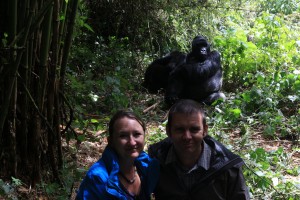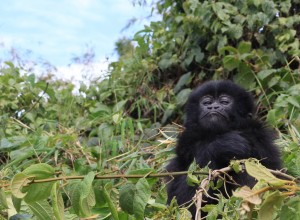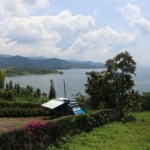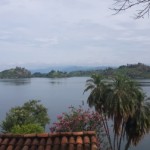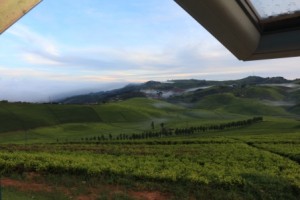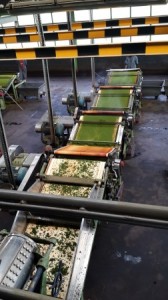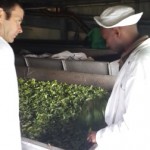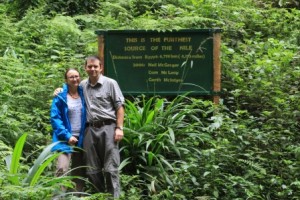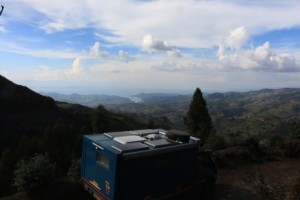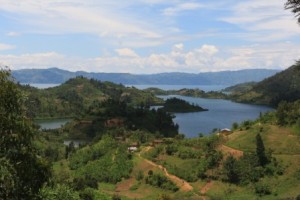November 2014
Rwanda Overlanding Blog – Gus the Gorilla!
Leaving Tanzania into Rwanda over the Rusumu Falls border, our priority was to head to the capital Kigali to arrange a gorilla trek. Luckily, November is not peak season for the gorilla trekking and the nice lady in the national parks office sold us a trekking permit for a few days’ time.
So we had a couple of days to look around Kigali and re-stock the food (by the way… fabulous supermarkets in Kigali!) then we headed over to the Volcanoes National Park on the DRC border, for our long awaited date with Gus the Gorilla! This was one of the very few absolutely key ‘must-do’ items on our agenda for Africa; to say that we were really looking forward to it is a bit of an understatement 🙂
So how was it? In a word… awesome! A truly special experience. The trekking is well organised and professional, with the interests of the gorillas always taking priority. It is not a ‘high-volume’ tourist-trap activity (the price-tag ensures this!) and only around 60 trekking permits are issued per day.
Each group (of no more than 8 trekkers) is allocated a different part of the jungle to go out to find the gorilla family resident in that part of the jungle. With each group are two professional guides, porters to carry your stuff (bags with cameras, water, snacks, extra clothing etc) and some armed escort soldiers. An advance team of expert trackers heads into the jungle at dawn to find where Gus and his family have settled that morning. Once they have found the area, the trackers radio the location to the guides, so that they can take the trekking group on a fairly direct route to visit Gus.
Well, we say “… fairly direct route…” but let’s not forget this is a jungle on the side of a volcano in Central Africa! Where there is a path, it is often steep, muddy and slippery. In many places there is no pre-cut path to follow: the guides and porters use machetes to cut through the dense bamboo jungle and you have to scramble up the mountain to find a way through to Gus. But the team really does try to make the route as passable as possible and the porters are on-hand to assist you if you get stuck! For anyone considering the trek: if you do your research before you go (read the guide books etc) and wear the right clothes/boots, it is an adventurous but not an unduly arduous experience for anyone with a basic level of fitness.
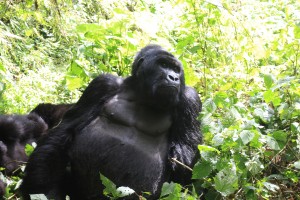 We loved the trek and had an amazing experience, it is a real privilege to get so close to these extraordinary relations of ours in their natural environment. In a jungle clearing, we sat surrounded by a whole family of gorillas who didn’t seem to mind our proximity in the slightest: Gus the alpha-male silver-back, his harem of several ladies, plus their numerous off-spring (all ages from adolescents to tiny new-borns)! We could bore you with reams about this stuff, but as they say… ‘a picture paints a thousand words’. Click here for full Gorilla Gallery and here is the video:
We loved the trek and had an amazing experience, it is a real privilege to get so close to these extraordinary relations of ours in their natural environment. In a jungle clearing, we sat surrounded by a whole family of gorillas who didn’t seem to mind our proximity in the slightest: Gus the alpha-male silver-back, his harem of several ladies, plus their numerous off-spring (all ages from adolescents to tiny new-borns)! We could bore you with reams about this stuff, but as they say… ‘a picture paints a thousand words’. Click here for full Gorilla Gallery and here is the video:
Yet Another Big Lake!
A kind of ‘Big Lake’ theme seems to have emerged on our African tour. So far we have spent time by Lakes Kariba, Malawi, Tanganyika and Victoria. We now head on to the lake forming most of the border between Rwanda and the Democratic Republic of Congo – Lake Kivu. Not the most famous of the great African lakes (we have to admit not having heard of it before coming to Africa) and we were not sure what to expect.
We joined the lake in the northern border town of Gisenyi and were pleasantly surprised by the pretty shore-line. After a few days relaxing there and catching up on laundry…. again (does it ever end??? 🙂 ) we took the route south to Kibuye.
This is a rough, slow road and the scenery was rather flattened by low cloud, but in better conditions it has potential to be a lovely drive. When we eventually reached Kibuye, it turned out to be even more beautiful than Gisenyi – a very pretty shore-line, dotted with scenic inlets and tiny off-shore islands.
In Kibuye we met travellers Reka and Ashley. Ashley is a motorbike traveller from a country of many overlanders: Australia! But Reka (sorry Reka – not sure whether we have spelled your name correctly) is the first Japanese traveller we have met and she impressed us with her trip so far: putting her car on a ferry from Japan to Russia, then driving on her own all the way from Vladivostok westwards across to Europe, south into Morocco and then all the way down the western side of Africa, before heading north again up the eastern side of Africa – an awesome journey for a single girl!
When we left Kibuye we headed further south again down the shore-road and were completely blown away by the stunning views on that section of road… we are truly not exaggerating when we say that this is one of the most picturesque routes that we have driven in Africa so far!
On a very sad foot-note to our time in Kibuye: when we met Ashley and Reka the conversation came around to Dean and Tanya, the young Aussie couple who we had met back in Malawi and who, like Ashley, were touring Africa on a motorbike. Ashley and Reka had met Dean and Tanya on the road too, but shocked us deeply by revealing that tragically Dean and Tanya had both been killed in a recent road accident, knocked off their motorbike in Uganda. This terrible news saddened us greatly and our thoughts are with their families back in Australia.
Tea Please!
Working our way up into the mountains overlooking Lake Kivu, we next headed (via a rather circuitous route due mostly to an absence of decent sat-nav mapping!) to the tea-plantation of Gisovu.
We arrived late afternoon at the plantation gate and it took them some time to find an English speaker to help us. After much smiling and gesturing, we were ushered in to meet the assistant manager, a charming young Indian chap named Justin.
Justin arranged for us to meet the plantation manager to seek permission to camp that night and have a factory tour in the morning. We were then escorted to a very scenic spot to park Cuthbert on top of one of the plantation hills near Justin’s staff villa, with spectacular views over the plantation and down to Lake Kivu in the distance. Not only was Justin extremely friendly and helpful in settling us into our camp-spot for the night, it was also exceptionally kind and hospitable of him to invite us to his home for dinner that evening – his staff would be cooking his favourite Indian curries and chapattis.
We arrived for the dinner at the arranged time, which was also just in time to catch the unmistakable sound coming from the kitchen of the live chicken being prepared for the pot! Wow! We were honoured to have the most delicious (and very fresh!) food prepared for us and would like to thank again, Justin and his staff for a most enjoyable evening. We learned so much from Justin about the tea industry in India and Africa.
The next morning at dawn, parked on a hillside in the middle of a Rwandan tea plantation, we awoke to one of the most beautiful views we have seen from our bed in Cuthbert. The sun came up over the morning mists drifting down the valley – spectacular. Only sad that we didn’t manage to capture it very well in the photos.
Later we took a tour of the tea factory, personally guided by no less than the Chief Tea-maker! Building on the background that Justin had explained to us the night before, we saw the fascinating process of how the green bushes are turned into the brown tea-leaves for your breakfast cuppa! The Gisovu plantation supplies tea to, amongst others, Taylors the producers of Yorkshire Gold tea in UK; so we could well have seen your morning cuppa for early 2015 being passed along the production line this week!
How could Top Gear not find this?
Just a few miles down a rough track from the Gisovu Tea Plantation, there is a sign at the side of the track pointing down a path into the jungle: ‘To the Furthest Source of the Nile’. Who could possibly drive past such a sign without investigating?
Any Cuthbert followers who also followed the UK series of Top Gear last year, will have seen Jeremy Clarkson, Richard Hammond and James May racing through Rwanda and Burundi (and also Tanzania?) to find the source of the Nile. Well, all we can say is that they can’t have looked too hard… it’s here chaps!!! Not exactly the most spectacular attraction, but a satisfying ‘tick in the box’ for overlanding Africa 🙂 .
After the Nile-source jungle adventure we headed south to Huye/Butare. Here we couldn’t find a campsite, so we persuaded the nice ladies at the National Museum to let us park in their garden car-park overnight. Next morning, we were on-site ready to visit the displays when they opened the doors at 08:00 hrs! Not quite on the scale of the V&A, but this is definitely one of the better museums that we have seen in Africa; an interesting insight into Rwandan geology, history and culture, taking up a couple of hours in the morning before we headed back up to Kigali.
So what about Rwanda?
As we now re-stock again with food and fuel ready for our onward route north into Uganda, we wonder why we have met so few other travellers in this tiny but spectacular country. Perhaps Rwanda is suffering with a reputation from its gruesome recent past, in the same way as Vietnam did for 20 years? But in case the message isn’t yet out there on the world stage…… that is all now long, long over! And the tiny nation is well worth a visit if you happen to be passing the area… or even if you’re not!
One thing that is rapidly apparent on crossing the border into Rwanda, is that people take great pride in their country: they are out there sweeping away the dust in their town streets and weeding the verges of the country roads. The buildings in the villages are, by distinct contrast to much of Africa, clean and brightly coloured, with immaculate exterior paint-work (albeit this paint-work is invariably in the corporate colours of, and bears the company logo of, one of the main mobile network providers or one of the local beer brewing companies!).
Here’s a fact you may not know…… plastic bags have been outlawed in Rwanda. Whoever thought of this idea and enacted this law should receive a Nobel Prize for Good Stuff. The country is without question the cleanest, neatest, tidiest country that we have visited in Africa, no… the world! Over the rest of Africa lies a thin but consistently scattered blanket of discarded small plastic bags, in each of which once sat an overripe tomato on its way home from the market. But not in Rwanda! Thanks to the ‘no-plastic-bag-law’, biodegradable paper bags are used in shops and markets and there is simply no litter anywhere. Brilliant!
And another fact about Rwanda… the last Saturday of each month is Umuganda (Public Cleaning) Day. Between 08:00 and 11:00 hrs there is a countrywide ban on road traffic and the whole country takes on community work (anything from street cleaning to road repairs, tree planting or maybe building homes for the less fortunate). As with the bag-ban idea… we hope that the inspired creator of this concept is fêted widely and given some richly deserved public recognition!
Muddy road out
Our final stop on our way north out of Rwanda was one night at near Kayonza at the small Lake Mohasi. Not much to say about this place and with hindsight we can say that this was not really worth the detour out of Kigali, but you never know these things unless you try them J.
From there we took a cross-country route to the Gatuna border with Uganda, but after almost 24 hrs of intermittent rain, this route turned out to be a bit muddier and more challenging for Cuthbert than we expected! In addition, we are finding as we head into the very rural areas of Rwanda that the sat-nav mapping is often inaccurate, showing roads that don’t exist! After a few wrong turns (and some wheel-sliding in the mud as the field workers looked on in amusement) we eventually reached the main tarmac road for the last few miles to the border.
Summing up Rwanda, the country is very beautiful: it has an extremely picturesque lakeshore and thousands of scenic green hills, tea and banana plantations… not to mention the unforgettable gorillas in the northern Volcanoes National Park. But if there is a down-side to Rwanda, it has the worst driving and the most dangerous roads that we have encountered so far. We saw more accidents in our two weeks in Rwanda than we have seen over the rest of our six months in Africa. Dangerously speeding cars, masses of swerving bicycles and mopeds, mini-busses over-taking on blind bends are all part of a daily drive on Rwanda’s roads.
The rough rural roads are invariably safer than the main tarmac roads as the vehicles are unable to reach dangerously high speeds. However Rwanda has a rolling programme of tar-surfacing the more popular rough routes. This is allowing the poorly maintained vehicles to reach greater speeds, resulting in potentially more tragic consequences of the bad driving.
On the positive side, we have been genuinely been amazed by Rwanda and had a lovely time here. The last thing that we expected to find in central Africa was a clean, tidy country, with fresh and brightly painted shops and homes, good surfaces on the main roads, properly finished streets with well laid kerbs and pavements, and neatly weeded verges on the country roadsides. Even in the remote (muddy!) rural areas that we passed through on our final route to the border, there was a real sense of pride in the appearance of the environment. The people of Rwanda have much to be proud of.
Cuthbert’s off to Uganda next…. it has a lot to live up to 🙂
Here is a quick overview map of our route in Rwanda.
Tune in shortly for the next news as Cuthbert heads north with the Uganda Page!

